Soaproot Saddle NEON (SOAP) Soil Descriptions
Distributed Soils Reports
Pedon Descriptions
Pit‐level observations and field measurements reported using the standard NRCS format. They contain volume estimates for coarse fragments > 20 mm where applicable.
Site Level Plot Summary
A narrative summary that places the sampled soil pedons in the broader context of soils and geomorphology for the entire NEON site.
Megapit Images
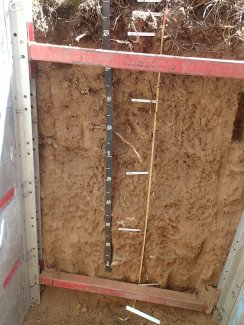
D17 SOAP megapit soil profile 0-200 cm
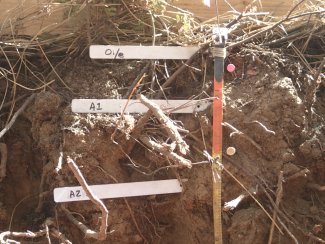
D17 SOAP megapit soil profile 0-30 cm
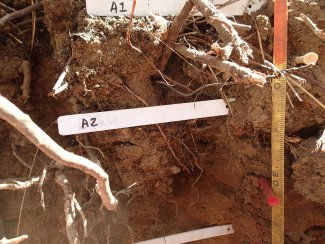
D17 SOAP megapit soil profile 12-36 cm
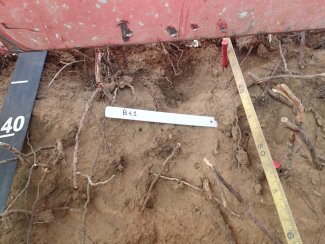
D17 SOAP megapit soil profile 30-60 cm
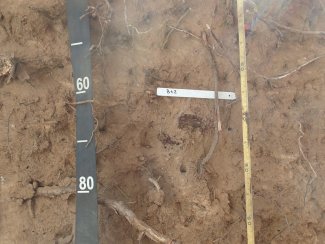
D17 SOAP megapit soil profile 47-94 cm
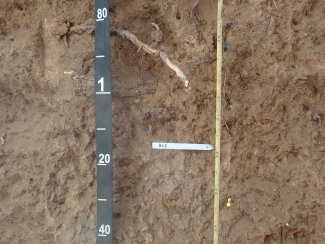
D17 SOAP megapit soil profile 81-144 cm

D17 SOAP megapit soil profile 122-200 cm
Megapit Pedon Description
| Print Date | Feb 7 2018 |
|---|---|
| Description Date | Aug 15 2016 |
| Describer | Phil Smith, Rafael Ortiz, Nelson Velazquez |
| Site ID | S2016CA019003 |
| Pedon ID | S2016CA019003 |
| Lab Source ID | KSSL |
| Lab Pedon # | 16N1953 |
| Soil Name as Described/Sampled | Holland |
| Classification | Fine-loamy, mixed, semiactive, mesic Ultic Haploxeralfs |
| Pedon Type | undefined observation |
| Pedon Purpose | laboratory sampling site |
| Taxon Kind | family |
| Physiographic Division | Pacific Mountain |
| Physiographic Province | Pacific Border Province |
| Physiographic Section | Sierra Nevada |
| Geomorphic Setting | on backslope of side slope of hillslope on mountain |
| Upslope Shape | linear |
| Cross Slope Shape | concave |
| Particle Size Control Section | 52 to 102 cm. |
| Description origin | NASIS |
| State | California |
| County | Fresno |
| MLRA | 22A -- Sierra Nevada Mountains |
| Soil Survey Area | CA750 -- Sierra National Forest Area Parts of Fresno, California 2-SON -- Sonora, California |
| Map Unit | 137 -- Holland family, 35 to 65 percent slopes |
| Quad Name | Shaver Lake, California |
| Std Latitude | 37.0327000 |
| Std Longitude | -119.2622100 |
| Latitude | 37 degrees 1 minutes 57.72 seconds north |
| Longitude | 119 degrees 15 minutes 43.96 seconds west |
| Datum | WGS84 |
| UTM Zone | 11 |
| UTM Easting | 298789 meters |
| UTM Northing | 4100893 meters |
| Primary Earth Cover | Tree cover |
| Secondary Earth Cover | Conifers |
| Surface Fragments | 1.0 percent nonflat subangular indurated 250- to 280-millimeter granite fragments |
| Description database | KSSL |
| Diagnostic Features | mollic epipedon 4 to 32 cm. argillic horizon 52 to 213 cm. |
| Slope (%) | 15.0 |
| Elevation (meters) | 1,202.0 |
| Aspect (deg) | 180 |
| Drainage Class | well |
| Horizon Details |
Oi--0 to 4 centimeters (0.0 to 1.6 inches); very dark gray (10YR 3/1) slightly decomposed plant material; . Lab sample # 16N09010 A1--4 to 18 centimeters (1.6 to 7.1 inches); grayish brown (10YR 5/2) loam, very dark brown (10YR 2/2), moist; 50 percent sand; 10 percent clay; medium granular, and fine subangular blocky structure; soft, very friable, slightly sticky, nonplastic; common medium roots throughout and common coarse roots throughout and common coarse roots throughout; few medium tubular and common fine dendritic tubular pores; 4 percent fine mica flakes, muscovite; noneffervescent; neutral, pH 6.8, pH indicator solutions. Lab sample # 16N09011 A2--18 to 32 centimeters (7.1 to 12.6 inches); yellowish brown (10YR 5/4) loam, dark brown (10YR 3/3), moist; 50 percent sand; 10 percent clay; fine subangular blocky, and medium granular structure; soft, very friable, slightly sticky, nonplastic; common very coarse roots throughout and common medium roots throughout and common fine roots throughout and common coarse roots throughout; few medium tubular and common fine dendritic tubular pores; 2 percent fine mica flakes, muscovite; noneffervescent; neutral, pH 6.8, pH indicator solutions. Lab sample # 16N09012 AB--32 to 52 centimeters (12.6 to 20.5 inches); brown (7.5YR 5/4) and brown (7.5YR 4/4) loam, dark brown (7.5YR 3/4), moist; 50 percent sand; 10 percent clay; medium subangular blocky structure; soft, very friable, slightly sticky, nonplastic; common very coarse roots throughout and few medium roots throughout and common coarse roots throughout; few medium tubular and common fine dendritic tubular pores; 2 percent fine mica flakes, muscovite; noneffervescent; neutral, pH 6.8, pH indicator solutions. Lab sample # 16N09013 Bt1--52 to 91 centimeters (20.5 to 35.8 inches); brown (7.5YR 4/4) and strong brown (7.5YR 4/6) sandy clay loam, dark brown (7.5YR 3/4) and brown (7.5YR 4/4), moist; 50 percent sand; 30 percent clay; 40 percent (7.5YR 4/4) mottles; medium subangular blocky structure; slightly hard, friable, slightly sticky, slightly plastic; common very coarse roots throughout and very few medium roots throughout and few coarse roots throughout; few medium tubular and common fine dendritic tubular pores; 4 percent faint 5YR 4/4), moist, clay films on surfaces along pores; 2 percent fine mica flakes, muscovite; noneffervescent; neutral, pH 6.8, pH indicator solutions. Lab sample # 16N09014 Bt2--91 to 136 centimeters (35.8 to 53.5 inches); reddish brown (5YR 5/4) and light brown (7.5YR 6/4) and brown (7.5YR 4/3) clay loam, reddish brown (5YR 4/4) and brown (7.5YR 4/4) and brown (7.5YR 4/3), moist; 40 percent sand; 30 percent clay; 5 percent (7.5YR 6/3) and 25 percent (7.5YR 6/4) mottles; coarse subangular blocky structure; hard, friable, slightly sticky, slightly plastic; common very coarse roots throughout and very few medium roots throughout and very few fine roots throughout and very few coarse roots throughout; common fine dendritic tubular pores; 4 percent faint 5YR 4/4), moist, clay films on surfaces along pores; 2 percent fine mica flakes, muscovite; 1 percent subangular less than 300-millimeter granite fragments; noneffervescent; neutral, pH 6.8, pH indicator solutions. Lab sample # 16N09015 2Bt3--136 to 213 centimeters (53.5 to 83.9 inches); yellowish red (5YR 4/6) clay loam, dark reddish brown (5YR 3/4), moist; 40 percent sand; 39 percent clay; coarse subangular blocky structure; extremely hard, firm, slightly sticky, moderately plastic; very few very fine roots throughout; common fine dendritic tubular pores; 10 percent prominent 2.5YR 3/6), moist, clay films on all faces of peds; 5 percent fine mica flakes, muscovite; 1 percent subangular less than 290-millimeter granite fragments; noneffervescent; neutral, pH 6.8, pH indicator solutions. Lab sample # 16N09016 2C--213 to 255 centimeters (83.9 to 100.4 inches); pink (7.5YR 7/4) and reddish yellow (7.5YR 7/8) and reddish yellow (7.5YR 6/6) loam, light brown (7.5YR 6/4) and strong brown (7.5YR 5/8) and yellowish red (5YR 4/6), moist; 45 percent sand; 26 percent clay; structureless massive; hard, friable, slightly sticky, slightly plastic; common fine irregular pores; 8 percent fine mica flakes, muscovite; noneffervescent; neutral, pH 6.8, pH indicator solutions. |
Credits: This megapit soil pedon description was generously created by USDA Natural Resource Conservation Service staff, with particular thanks to Larry West, Jon Hempel, and numerous field staff.